Khukuri Styles
Back to Main FAQ Page

One thing is certain, necessity is the mother of invention. Nepal ranges in
altitude from about 300 feet to almost six miles and the khukuri requirement
for people living at the 15 to 17 thousand foot altitudes is much different
from those living in the jungle at 300 feet. Khukuris adapted to conditions.
This is the reason for many different styles and sizes.
Khukuris as weapons also depended on what job they were supposed to do.
Men who defended the wall under siege used very large and heavy blades --
often koras rather than khukuris. Infantrymen whose job it was to strike quickly
used lighter and faster khukuris.
A different khukuri for different needs. How many styles and sizes? Like
the leaves on trees.
Bill Martino
ang khola
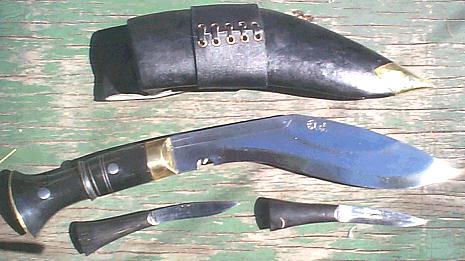
The Ang Khola has a characteristic forged depression that helps to distribute
the weight forward on the blade. Ang Khola means “curved spine,” apparently
referring to the raised region on the edge of the depression. The Ang
Khola is a powerful chopper. HW
Ang Khola means “back-valley” or "back-hollow", referring to the
depression near the spine ('back') of the blade. BMS
Joel McNamara's review of a 15" AK
Yvsa's review of an 18” AK
Will Kwan's review of the 15" AK and the WWII
Cliff Stamp's review of the 15" AK
Another Cliff Stamp review of the 15" AK
Cliff
Stamp's review of the 20" AK
Balance
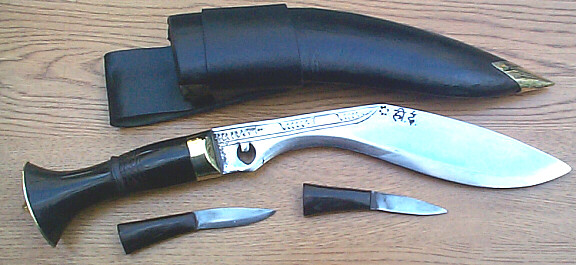
This is 13 inches overall. Blade a bit less than 3/8 and width is just
over 1.5 inches. Weight is about 11 oz. Brass inlay and scrollwork.
Banspati


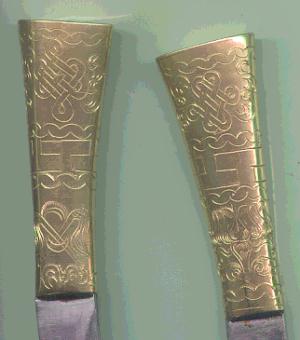
The Royal Kami, the old master kami who makes khukuris for the king of Nepal
and a few higher ups, dropped by shop 2 to make me a "Banspati" khukuri and
here it is. "Banspati" means bamboo leaf.
I have seen perhaps two or three hundred commercial copies of this knife
over the years and did not see one I cared to purchase. But this one is one
of the finest examples of both metal craftsmanship and engraving I have ever
seen. And, the kicker is, the Royal Kami did the engraving himself -- three
to four day effort.
The blade is recycled spring and excellently done, handle is brass sheet
("thick") imported from Japan. Handle is engraved with symbols similar to
those seen on karda and chakma, including "Sri Pance" the symbol of royalty.
Notice Nepal motif of tiger, yak, elephant and owls. 27 inches and
four pounds of excellence. [Bill Martino]
Bhojpuri
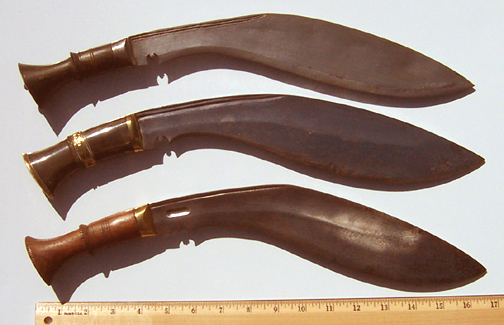
This style of khukuri comes from Bhojpure in Eastern Nepal. The town
of Bhojpure is one of the major manufacturing areas for khukuris.
Here are three good examples. This term "Bhojpuri" is almost a catchall
phrase like sirupate/sirupati for a long, slender knife. The most obvious
characteristic is the deep belly and forward sweep of the blade. These blades
are quite well made and and top example is a Nepali military issue from the
late 1800s. The other military piece on the bottom is from the 20's.
bhudhini

It is a great lopper and chopper. And while not light, it has a flow to
it that would make it formidable in battle. These are also of the approximate
size used in the ceremonial sacrifices mentioned occasionally. HW
Budhume
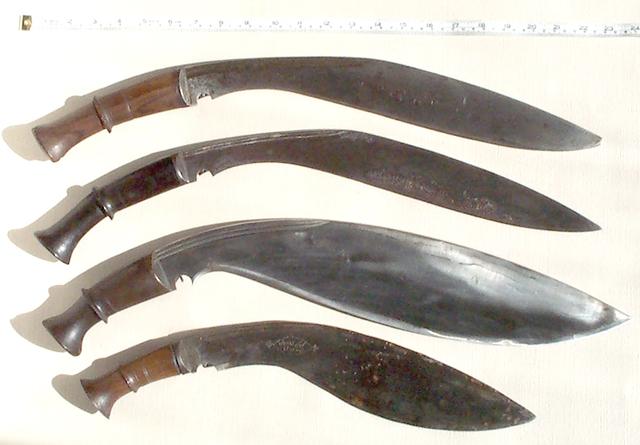
Here is a photo of 4 very old kukris. 1780-1820. You can easily see the
pronounced 'drop' and the type grips. These are referred to as "hanshee" or
full arc.
Many people feel that the knife has to be long and slender to be ancient,
but the 2 "budhume" or big belly show just how large these old knives could
be.
For some reason the scabbards on the thinner blades are rarer than on the
"budhume' blades. JP
Chainpuri
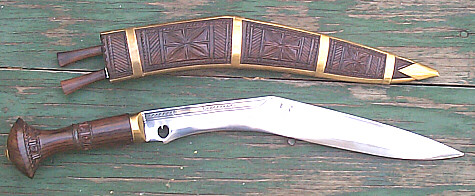
A 20" Chainpuri.

A 17" Chainpuri.
The chainpuri style is characterized by the bell at the bottom of the handle
and a light blade. It is named after a small village in eastern Nepal.
Chainpur is down in the lowlands where the terrain is jungle mostly.
The Chainpuri is a bit more sharply angled at the top than a Sirupati. A
closed "eye of the dove" cho characterizes this style.
Chitlangi
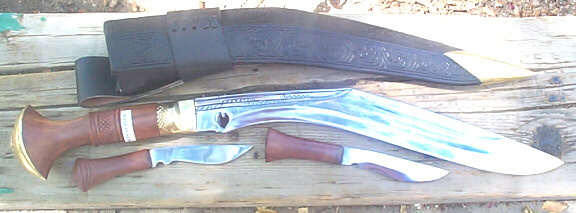
The differences between a Sirupati, Chainpuri, and Chitlangi are subtle.
The Sirupati may be slightly beefier and therefore a slightly better performer
when it comes to chopping but it would not be by much.
In the western part of Makwanpur district of Nepal, by the Chandragiri
Mountain range, there is a historical village called Chitlang. I assume
that it is this village that gives the Chitlangi it's name.
Cho
The cho is the characteristic cutout near the base of the blade. The
chainpuris above have "pariwa ki aka" or "single eye of the dove" chos, while
the BAS above has the most common "kowdi" or "cow track" cho.
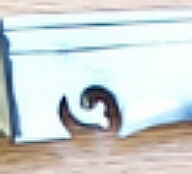
I do not know the name for this unusual cho.
Dhankuta

Dhankuta is located in SE Nepal. The population is largely Rai and Limbu
which makes the Sirupati a very popular khukuri in that area. But the Sirupati
is not geared for some jobs so the make a very standard looking khukuri which
generally has a little "hump" (like a camel) on the back of the blade. Why,
I can't tell you and the hump is not always there. Bill Martino
15" Dhankuta review by
Chiro75
Eighteenth Century (HI)

Replicated after an ancient khukuri in Nepal's National Museum. It
is 19 inches in length and about 2.1 wide. Weight 1 lbs 14 oz.
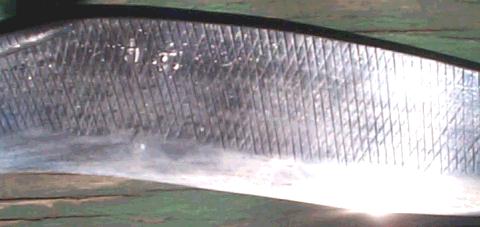
This style has cross hatching on the surface of the blade.
forward curving
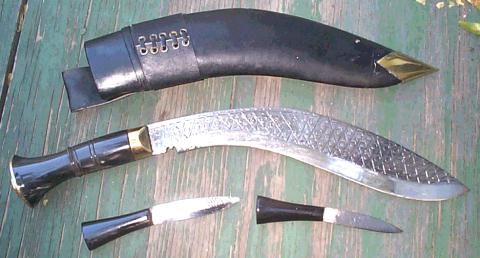
The forward curving style is characterized by the smooth curve on the back
of the blade. On some knives this curve will extend through the handle
portion of the knife. The forward curving style is often seen on older
battle blades.
Forward Curving Review
by Will Kwan
Gangaola

My father-in-law told me that khukuri was a "gangaola" khukuri and he usually
knows what he's talking about. But I didn't ask him what the name meant.
I think it means a "ganga chopper" but I am not positive. Ganga (marijuana)
grows like the weed it is in Nepal and is a real pest for farmers. Up at
Yangdu's farm they cut (but not with a gangaola) and burn probably a million
bucks (US market) worth a year so they can grow corn and potatoes.
That little flat piece of leather is meant to be a tinder holder. Before the
cigarette lighter the khukuri scabbard always contained the necessary ingredients
for making a fire. During monsoon in Nepal everything is wet so one needed
a little dry tinder to get things going.
Bill Martino 2/24/99
hanshee or full arc See also Budhume and forward curving.
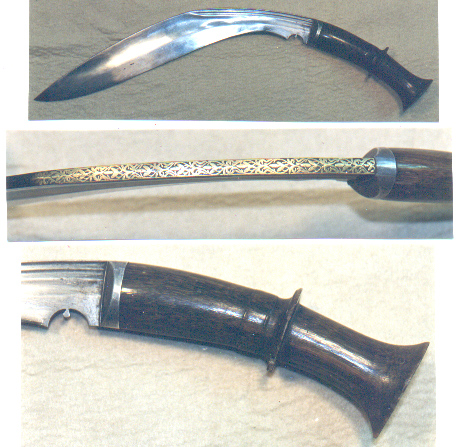
This is a very nice example of an early 19th/late 18th century 'hanshee'
probably of southern Nepalese origin with a beautifully done gold foliate
design along the spine to the end of the double fullers at the shoulder.
Overall size of 15.75" would indicate this was a khukuri for a young man
with status or even possibly from a ruling jat. The blade appears to be finely
finished and highly polished which would be typical of something like this.
JP 06/01
Hanuman
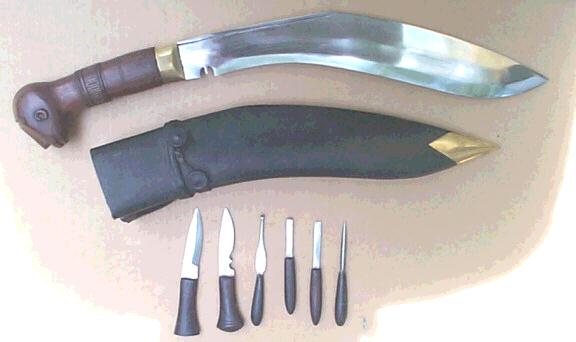
There was no such thing as a Hanuman khukuri until we made one. We replicated
the blade on the original but put Hanuman in place of the Lion and because
of this we named the knife a Hanuman khukuri.
Hanuman is a much valued god in Hindu tradition especially when one finds
oneself on the field of battle, and many Gorkhalis pray to him before going
into battle.
The original had an ivory handle with the lion head, surely a British officer's
khukuri, and is on display at the Royal Armories in the UK. It was manufactured
around 1850 and is a beautiful piece.
The kamis are all Hindu and they felt if they were going to make a khukuri
it should carry a Hindu-Nepal influence rather than a British influence. I
could not argue with them about this.
Kami Sherpa
I won't be using Hanuman for a field blade. Much too pretty. I haven't
seen the blades that most people use for the martial arts, but this one whispers
'weapon' in my ear. I am going to keep Him on the headboard ready for "unwanted
guests" and "noises in the night" I found out years ago there is nothing
like a walk around the house in the dark with a blade glistening in the moonlight
to dispel some of those noises.
Yvsa
Janawar katne
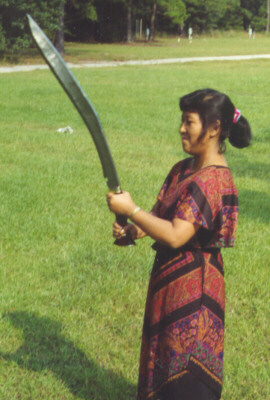
Literally “animal cutter.” Khukuris of this size are primarily produced
for the tourist market. For actual sacrifices, somewhat smaller khukuris
are usually used. HW
kagas katne (minatures)
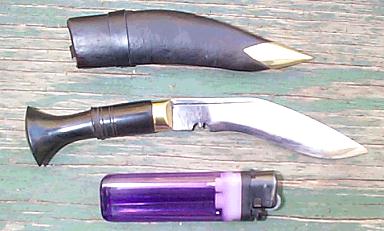
Kagas katne means "paper cutter" and it is a small khukuri used for opening
envelopes and the like. Usually not functional for anything but cutting paper
BM 8/1/99
HI recently began importing kagas katnes of high quality. They have
found a following among khukuri aficionados, who use them for many tasks
other than cutting paper. HW 1/4/2000
Miniatures were used as 'favors' at certain Regimental Mess ceremonies,
or as 'sweetheart pins' or as a trinket or oddity to show a kami's skill.
Numbers 3 and 5 below are Victorian era pieces including English silver proof
marks! #5 is solid gold and according to my anthropologic jewelers has a
very rare rosegold technique on the grip. These were all made in the UK between
1860-1875. I think the others were made in India or Nepal. The picture at
the bottom is a cu of #5
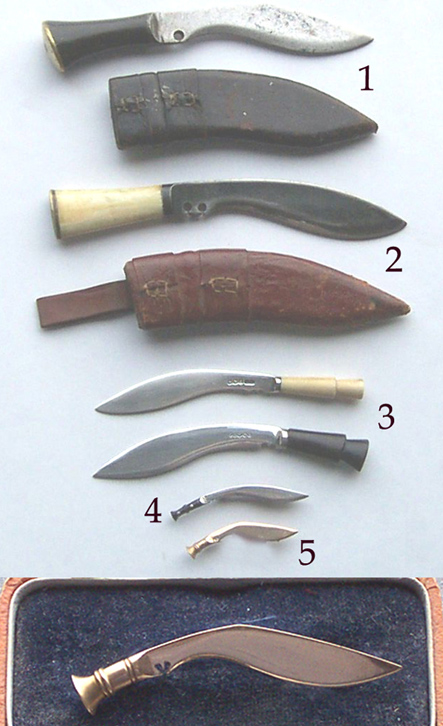
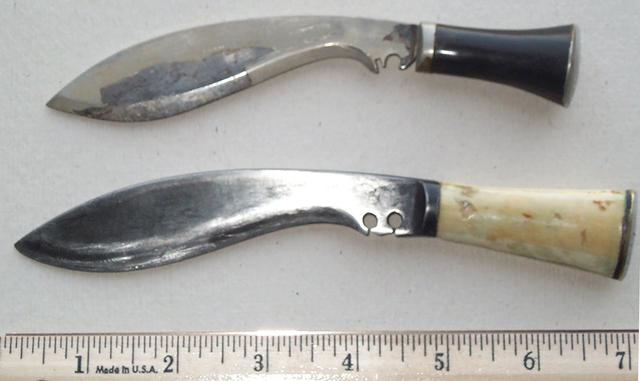
kothimora (or kothimoda)
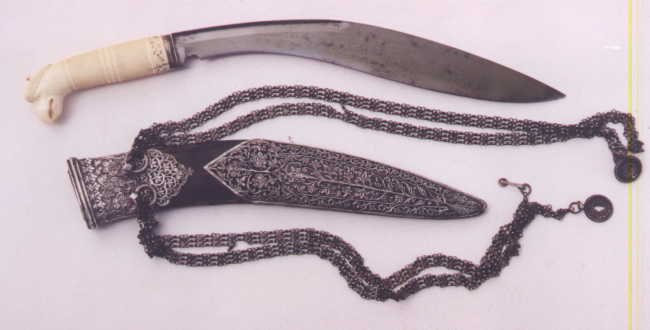
Photograph courtesy of Artzi Yarom.
Pala (Kami Sherpa) said the meaning of kothimora to him and most people
was simply "rich man's khukuri". The word refers to the scabbard more than
the khukuri itself. The true kothimora will have two, three or four ounces
of silver (and sometimes gold) ornamentation on the scabbard. The touristy
version has much less and sometimes the "silver" is not silver at all but
what the kamis call "white metal" (probably nickel silver.)
John Powell owns more kothimodas (or mora -- depending on who you are talking
to) than anybody I know and also knows more about them than me. If my memory
isn't failing me again he told me there were four different grades -- from
the cheap tinfoil type scabbard decoration to a scabbard with perhaps 5 or
6 hundred dollars worth of gold and silver decorations on it. The khukuri
itself is secondary to the scabbard.
And, I don't know if the same law prevails since the revolution in Nepal
which took a lot of power away from the king but I heard that in days gone
by a presentation grade of Royal or Military quality that was presented with
papers HAD to have the papers to back it up or it could not be legally owned.
I think by definition kothimodas have a highly decorated scabbard with
gold and silver. Bill Martino
More on kothimodas
Maccha
The fish style. The handle looks like a fishtail (macchapuchare)
the name of one of Nepal's most famous mountains. Bill Martino
Produced primarily for the tourist market. When hung on it appears
to be a decorative ornament rather than a knife. The handle of the knife
forms the fish's tail, and the wooden scabbard forms its body and head.
HW
Machaera
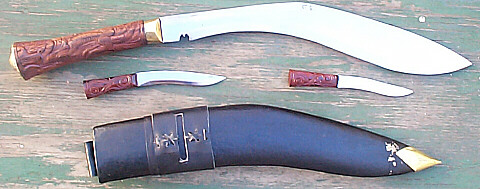
It looks like a khukuri but I think this is properly called a Machaera.
This particular one is 28 inches and weighs 3 pounds. Blade is 2 & 3/4
wide and 7/16 thick. The handle is Machaera rather than khukuri style. Karda
and chakma are 8 & 1/4 inch and excellently done.
Malla
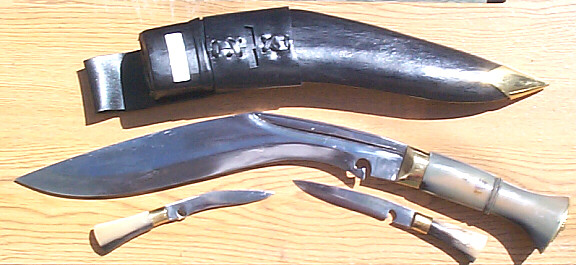
This is a replica of a khukuri found buried under the floor of BirGorkha.
It was nearly eaten up by rust but the kamis knew it was an old timer and
suggested to Gelbu that he take the remnant to HMG Archeological Society for
ID. The HMG experts figured it was a quality piece from the Malla period so
we are going to call this model khukuri the "Malla" khukuri. And, it generated
so much interest with HMG and the kamis that Kumar actually got more help
and advice than he wanted!
The khukuri is 19 inches, 2 inches wide, 7/16 thick and weighs about 2
& 1/4 pounds. There are a couple of unique things about the khukuri which
should be mentioned. The spine is flat (rather than in the traditional "V")
like my old Salyan, our logo khukuri. Karda and chakma are works unto themselves
with brass bolsters and chos.
Panna Butta or Chiruwa


Chiruwa means "split" and refers to the handle style which
most call a pana butta. Panna butta means "riveted through."
Reviews
18” AK review by Yvsa
Appearance:
I really like the plain buttcap on the Shop 2 knife. I like the diamond shape
keeper that Shop 1 uses. Personal preference and nothing to do with performance.
The handle isn't finished quite as nice, but is more than adequate as I am
being pretty nit picky here.
The size of the handle is perfect !! Neither my index or middle finger touches
the palm of my hand with this one. They did on the 15" AK handle.
The preparation before polishing makes the polish look like it is not as
good as Shop 1's is but I think it is better, at least on this one.
The scabbard is nicely made on this one and only needs some Kiwi to bring
it up to Shop 1 standards. The frog has 6 rivets on the back.
It was meant to stay.
The karda and chakma are 6 3/4" (4" blade) and 6 1/8" (3 3/4" blade) Very
nice size! I especially like the size of the karda. Getting used to the small
handle will make it a very usable blade. I reworked the karda. I smoothed
out some fairly heavy polished grind marks by the handle. I took the file
clear to the point of the karda and then filed a new bevel on each side keeping
the convex edge, but thinning it down a little. I also ground a little finger
groove at the base of the blade. The H. Epoxy had covered a nice little angle
leading into the handle and I cut that away with a
knife.
After I got it shaped like I wanted and smoothed out nicely with the file,
I put some file work along the spine and then used some emery paper on the
blade and polished it a little with the buffing wheel on the grinder. I don't
think I will polish it anymore because I am going to use it but I might to
help keep any rust down. A plus to all of this was touching up the polish
on the horn and seeing some nice little brown and white grain pop out of
it in a couple of places.
The stamping on the blade, no electric pencil, kinda adds to the charm
of the whole experience.
At least we can put initials with who made the knife now. I think the serial
numbers will add to the collectablity thing if anyone is interested in that.
Performance.
I took it out back and pounded on some hardwood logs.
I kind of knew what to expect with the 15" AK, but this one exceeds the 15"
in no uncertain terms. With about the same amount of effort it easily split
some Catalpa with one whack where it would take 2 or 3 with the smaller one.
I was also able to penetrate into the side of a log with greater depth. There
is only about 1/2 Lb. difference in the 2 khukuris, but there is much more
difference in performance. Even whacking it against the log using the spine
or either side of the blade produced none of those hand-jarring vibrations
that hurt.
One other thing I noticed about this one is the hardness of the blade. I
wanted to play with it a little and put a file to it. It just slide right
over about 3"- 4" toward the point.
I was a little concerned and took my trusty nail and performed the chop test.
I used a 16-penny nail and my little anvil log in my workroom. I didn't
take a really good swing for several reasons. I chopped it about 3/4
through. It indented about 1/2 mm and was about 1/2 mm long. No problem.
I worked it out with the diamond hone.
I think it is probably the Ideal hardness!
15" Dhankuta review by Chiro75
The folks at Himalayan Imports often go on expeditions to villages in Nepal
and pick up the best khukuris they can find made by local "kamis" (men who
make khukuris and other steel tools). While these are not made in-house by
Himalayan Imports, they carry their lifetime warranty and are real tools
meant to be used (as opposed to cheesy knock-offs intended for tourists).
The added bonus to the "villager" models is that these knives are sold at
a price that is about 1/2 or so the regular price of an HI khukuri of the
same size. I took advantage of a recent deal and received the khukuri yesterday,
so here's a review.
The main reason a villager model goes for so much less is that the finish
is usually rough. This Dhankuta (named after the town it comes from) is no
exception. First, the measurements. This knife has a 5" handle made of black
horn with a brass butt cap and "bolster". The blade is most likely 5160 carbon
steel from a truck or automobile leaf spring. It is 10.5" long. Measured
OAL appears to be 15.25". The blade is 7/16" thick and 3" wide at its widest
point. Khukuris traditionally come with at least two utility knives called
a chakma and a karda. One is a small knife that is sharpened and intended
for small work the large knife can't handle, while the other is an unsharpened
burnisher meant for steeling the edge in the field. Both have the same black
horn handles with light gray streaking.
The entire package fits neatly into a wood sheath that is covered in black
ox leather. The sheath is roughly made but it seems it will fit the purpose.
It does a nice job of securely holding all three knives as compactly as possible.
The utility knives are interesting. The unsharpened one is VERY roughly done
showing almost no finish work, and the blade is all bent up. It was probably
forged with a minimal amount of finish work. It is rather sloppily "epoxied"
into the handle, and the joint looks like it could need some reinforcement
from some real Western style epoxy. It has a 2" blade and is 4" OAL. At 180
degrees opposite, the sharpened utility knife has a 2.5" blade and 4.5" OAL.
The blade is straight, sharp, and is almost mirror polished. The blade is
set very well into the handle, too. The handle has been finished smoothly
while the other was still rough. I would almost say they were made by two
different people....
The khukuri itself has a few bends back and forth in the blade and the handle
is on slightly off center. It does not affect use at all, though. The blade
is lumpy and bumpy, but pretty sharp and still carries all the original grind
lines. It is ugly, and the spine isn't flat but rather beveled, but it is
a highly usable tool. This has the finish you'd expect from someone working
with the types of tools village kamis own. Actually, this knife is ten times
better than you would THINK if you saw those tools!
The edge is pretty straight and the choil bears the traditional much debated
cutout. The handle is very well-finished but the endcap rattled loose a bit,
which is easily fixed with epoxy. It represents no functional problem other
than the fact that the poor kamis don't have epoxy.
This knife is a true chopper, like all khukuris. It demolished a hard seasoned
4X4 in my backyard and the edge is barely worn from it. VERY impressive. The
village Dhankuta is VERY nicely balanced and is super tough. I LOVE it! The
fit and finish are rough, but the handle is very smooth and a lot of care
was taken to make it very comfortable to use. There is no vibration from
heavy chopping, either, which is a nice plus.
The Dhankuta performs better than a longer, heavier Cold Steel Gurkha Kukri
that has the advantages of a flat grind and Western manufacturing! I preferred
the balance of the HI Dhankuta over the Cold Steel. The HI feels slightly
heavier than the CS WITH its sheath, but in the hand it seems lighter and
more nimble. The shorter scale (probably two inches) and better balance make
it feel more nimble and requires less use of the forearm muscles to keep
its point straight. I was less fatigued using the HI than the Cold Steel
for these reasons.
I also like the fact that the HI serves as a sort of wedge due to the grind.
It has more blade with full thickness and therefore seems like it would be
stronger in the long run. It also gets caught less often and to a lesser
degree while still blowing massive chunks of wood off the test block. The
handle is less comfy on the HI Dhankuta, but it has tons more character.
I'd be happy to carry either in the field, but the HI is preferable because
of better balance, more mass, more control, and simple looks!
The fact that a village kami can make a knife to begin with is amazing,
given the circumstances, but the fact they can make a USABLE, durable, hardcore
khukuri like this is further testament to their status as artisans and craftsman.
I love the way this thing looks, and while it won't win any style points
at the next big show, it is beautiful in that a guy could take it an turn
an old car leaf spring into this wonderful, traditional tool.
I went out to the woods this week to get a really good idea of just how
well a khukuri chops. I have chopped on boards and stuff at home, but
I thought a more realistic test would be cool. The Dhankuta has a pretty sharp
edge, but nothing like shaving sharp.
I started on the first downed tree I saw. I am not a tree guy, so I have
no idea about wood types and whatnot, but these are all non coniferous (i.e.,
not pine or varieties thereof) typical Iowa woods trees. The one I went to
work on first was covering a mountain biking trail, so I decided it needed
to be eliminated. It didn't look real old, so it was probably freshly downed
(I would say within the last month or so). I went to work on the trunk, which
was probably a good 5-6" in diameter. I knew with the first chop that this
sucker was doomed! The blade suck in nice and far and I just started chopping
the hell out of it like crazy. I was mainly using the weight of the knife
do all the work, and the trunk was about at knee level. I was coming in at
an angle of about 35-45 degrees alternating every few chops between the left
and right side of the cut I was making. This technique made a nice wedge
cut really fast. Within thirty chops or so the trunk was rendered in half!
I was REALLY impressed! There was no edge deformation and it felt as sharp
as when I'd begun. So, satisfied with that I decided to see what it would
do with branches. I was REALLY surprised with this test! The branches I cut
were 2-2.5" diameter, and, honestly, the Dhankuta knife went right through
them with ONE CHOP at a 45 degree angle cut (which widens the effective diameter
considerably from the 2-2.5" estimate). I did this on three branches and
was giddy with the powerful feel of the khukuri!
My next mission was to tackle a much larger tree that looked to have been
there a lot longer. I would say this thing was a good 12-14" in diameter,
and it had no bark left on it. No rotting, either. It stood at a little higher
than waist height, too, which probably diminished my power, as well.
My first swing was full power and I knew right away this tree was completely
different from the last. The knife sank in about 1/4" and shocked my hand
a bit. Uh-oh! I went at it with all I had, though, and 30 minutes later of
continuous pounding I had a tree trunk that was about 1/3 cut through and
a tired, cramped, slightly bruised hand from the shock. I was sure the edge
would be dull as anything, but I checked it out and it felt as sharp as it
did when I began. That tree was ultra-hard wood!
I learned a few things:
1) If you are going to be doing a ton of chopping, throw on some padded gloves
or wrap the handle in padded cork handlebar tape from a bike shop.
2) A khukuri is no substitute for a 2-handed full size ax on a hard, large
tree.
3) A khukuri is better and more useful than the typical hatchet or axe on
smaller chores (i.e. splitting firewood at camp, etc.).
It did a lot better than expected, and I think tackled the super hard tree
pretty darn well myself. My hands gave out before the khukuri did!
Forward Curving Review by Will Kwan (11/99)
Summary
After some bush and light tree clearing, I am disappointed with the performance
of the forward curved khukuri (FWCK). The sweat spot is too small and located
too close to the tip. The forward angle may be too much. It is not my first
choice khukuri for what I typically do. The blade decorations are a hindrance
in the field. The blade decorations, interferes function of the chakma’s.
On a positive note blade is very good. It pierced a 55 gallon drum with no
damage and there was very minor rolling on the edge when I tried to chop
into the drum. The only other damage is a loose butt cap.
While I'm not impressed with its field performance it was so unusual I
bought the khukuri.
Preliminary Preparations
The FWCK passed the slap test made famous by Dave K. This is where the
blade is slapped against a tree on its flats hard. No damage was noticed.
The knife was sharpened so that it could shave hair from my arms readily.
There was a consistent burr on the edge of the khukuri. Sharpening took about
15 minutes with the course Spyderco stone. A straight section starts at the
beginning of the forward curve and runs for 5.5”. The stone slides over the
straight section easier than near the tip. The straight is harder than the
tip. The stone grabs much more near the tip. Unfortunately, the belly (where
the sweet spot is located) is included in the softer section.
Chopping Yard Waste
The FWCK was used to chop up some branches that I wanted to burn in a
55 gallon drum. The FWCK was stabbed into the drum to produce air holes. The
tip and edge was undamaged by this. A Mission MPK (A2) was also used to poke
holes into the drum and was also undamaged. I tried chopping on the sides
of the drum to produce larger holes with the FWCK. I could not chop through
the drum but put large dents into the drum. The knife was very slightly rolled
in four spots from chopping. The most severe damage was half circle peens
that are 0.25 mm in radius. These are barely visible and were steeled out
with the chakma from an 18” AK. Steel and heat treat must be pretty decent
in the FWCK.
I used a tree stump as a chopping board to assist in chop the branches
into smaller sizes. I found I could not use the straight section. As the tip
would impact against the stump before this section could contact whatever
I was chopping. Unfortunately, the straight seems to be the hardest section
of the FWCK. I then used the belly, which starts after the straight and ends
about 1” from the tip, to chop with. This must be the sweet spot. The results
were much better and I had no problems breaking through 4” diameter branches.
Chopping completely through them would take many more chops. I found the
sweet spot to be too small and located too close to the tip. The sweet spot
in the 2” belly. I used my 18” Ang Khola for a short time to compare its
performance to that of the FWCK. I could use the straight section and the
much larger belly of the Ang Khola as effectively as the belly of the FWCK.
After doing this for about 7 hours, the 6 years of branch accumulation was
burnt up. The tip was quite dull.
Trail Clearing
The following day, I used the FWCK, 18” Ang Khola, 17.5” WWII, and 22”
Sirupati to assist in opening 100 m of lane. Most of the trees that had to
be chopped down or had limbs removed are 4-6” diameter cedar.
The cedar trees were brought down by first chopping a V into one side so
that the tree could be pulled over. This required between 6-12 chops. After
each chop the khukuri was twisted hard to remove as much wood as possible.
I was surprised with the amount of variation in the number of hits required
for similar sized trees. Once the tree was pulled over the connecting piece
was chopped through using the stump as a chopping block. This usually required
only 1-2 chops. The whole process takes under 5 minutes. The cedar was found
to over 30 years.
When things worked well for the FWCK it gave similar performance as the
18” AK and 22” Sirupati. Cedar is very soft and it was more productive to
chop with the large straight section rather than the small sweet spot. The
tip would often strike or become entangle in nearby branches as I was using
the straight. While the belly did penetrate deeper it would not remove as
much wood as the straight. The WWII would sometime require only a couple more
chops.
The FWCK did not remove limbs as well as the other khukuris. I struck the
limb as close to the tree as possible for optimum results. In order to perform
as well as the other khukuris, the sweet spot must be used. I could easily
employ the larger sweet spots of the other khukuris. My aim was not good
enough to consistently hit with the sweet spot with the FWCK. Also, the belly
dulled faster than the straight of the other khukuris.
Larger and Slightly Harder Trees
I used the FW and 18” Ang Khola to bring down a 7” diameter dead spruce
tree. The spruce is definitely harder than the cedar. The FW was not used
for very long. It was mildly painful when the sweet spot was employed. There
was too much shock transmitted to my hands. The 18” Ang Khola ended up doing
most of the work. The 18" Ang Khola would still shave the odd hair after
chopping down the tree.
Prying
The FWCK was used to pry loose two trees that got caught on the remaining
stump and overhead branches. To move the trees the khukuri was used as a
lever. The fulcrum was located about 5” from the tip and 0.25” of the tip
was underneath the tree. Pulling on the handle with 60% of my 180-lb clothed
weight freed the trees. The FWCK deflected very little, about 3 degree. This
does not mean much since the trees were supported elsewhere but they were
well over 200 lb.
Blade Decorations and Maintenance
The engravings on the blade filled with mashed wood. This is difficult
to field clean. In order to remove all the wood trapped in the decorations
I had to wash the blade with hot soap and water.
**** The decorations on the chakma must go! The sides of the chakma do
not work with the hatching and circles. I know most people do not use these
and the edge can still be used, but they should be completely functional.
Copyright (c) 1999-2001 by Howard Wallace, all rights
reserved.
This FAQ may not be included in commercial collections or
compilations, or distributed for financial gain, without express written permission
from the author. This FAQ may be printed and distributed for personal
non-commercial, non-profit usage, or as class material, as long as there
is no charge, except to cover materials, and as long as this copyright notice
is included.




























